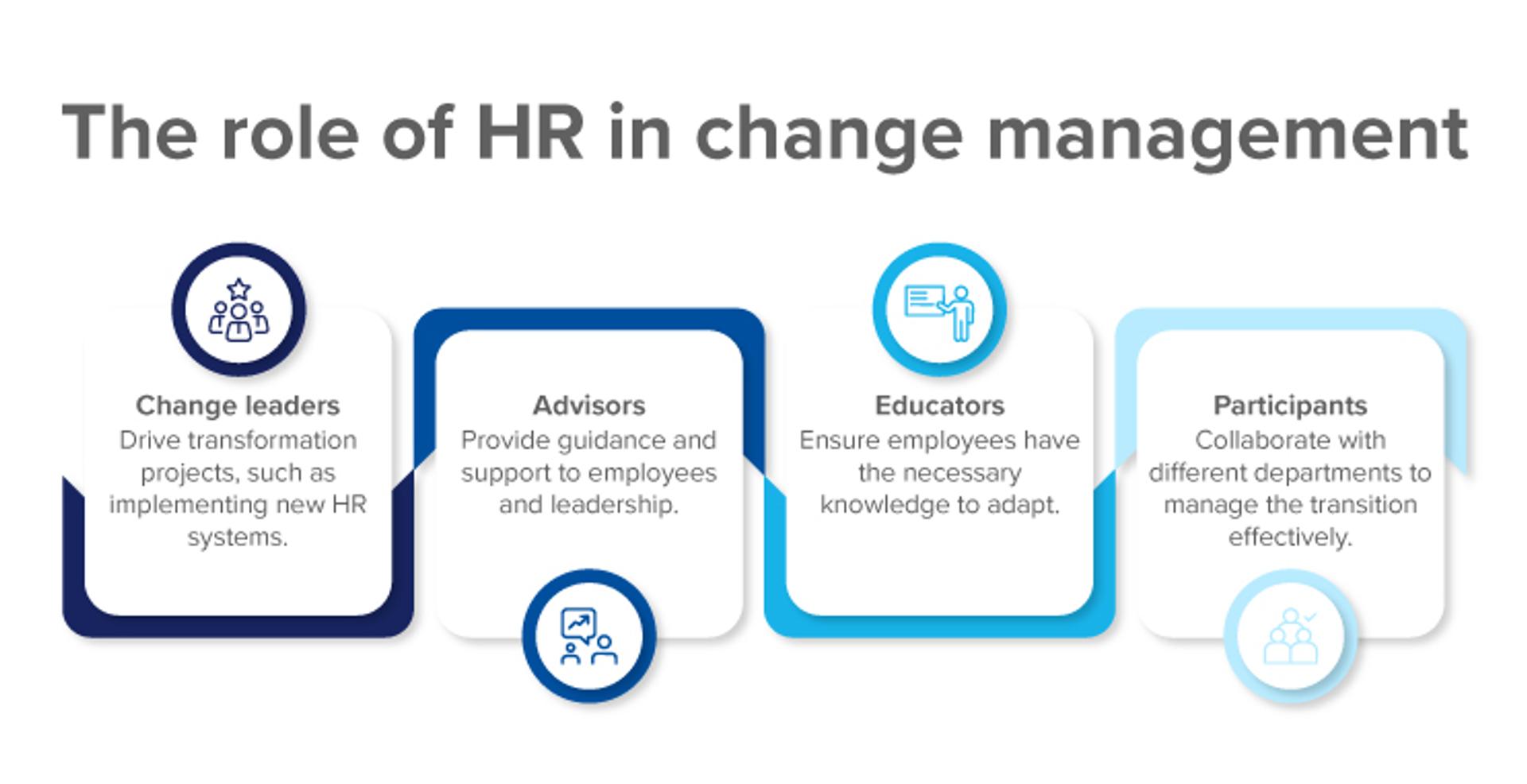HR change management: Guiding your organisation through transitions
Technological advancements, regulatory shifts, and strategic decisions can all prompt organisational change.
Elliot Raba

In the face of these constant shifts, HR change management plays a vital role. With effective change management, organisations can ensure smooth transitions, minimise disruptions and foster adaptability and resilience.
When change occurs, resistance is common. HR teams must carefully guide organisations through transitions. At the core of this process is structured planning and implementation. These elements help employees understand the necessity of change and equip them to engage with it positively. This article examines HR's role in change management, the key skills required, and the effective frameworks that support successful transitions.
Understanding HR change management
HR change management enables organisations to implement change effectively by providing structure and support. It involves guiding employees through transitions and ensures the adoption of new processes. A well-managed change process has the power to:
- Reduce resistance
- Maintain morale, and
- Improve overall organisational agility.
The role of HR in change management
HR professionals wear many hats to ensure successful change management by taking on multiple roles throughout the process. These roles are represented in the below chart:

Beyond these roles, HR also acts as the crucial link between leadership and employees. This connection ensures that strategic business objectives align with real-life workforce needs. By fostering a culture of openness and transparency, HR professionals can mitigate uncertainty and create a work environment where employees feel valued and supported.
Essential HR skills for managing change
To drive successful change, HR teams need effective communication, leadership, and analytical skills. Without clear communication, employees and leaders will struggle to understand the logic behind change. The less understanding there is, the greater the resistance organisations may encounter.
HR teams must prioritise strategic planning by assessing organisational readiness and clearly outlining implementation steps. Engaging employees during this process enhances participation and can address concerns of adaptability. Leadership must help build trust and motivate teams to embrace change.
Additionally, empathy plays another key role. Understanding employees' perspectives, acknowledging their concerns, and addressing uncertainties can significantly enhance engagement and acceptance. Conflict resolution can reduce tensions and resistance to change.
Key HR activities during change management
Two core activities are at the heart of HR change management: communication and feedback. Both play crucial roles in limiting the negative consequences of change.
1. Communication
Communication planning ensures employees receive clear, consistent messages about the transition. Organisations need to provide employees with proper training opportunities and maintain an open dialogue that helps maintain morale. Leadership engagement is a crucial element here, as leaders and executives must actively support and promote the change.
2. Feedback
The other core component is creating a feedback loop. Encouraging employees to share their challenges and experiences allows HR to adjust change management strategies accordingly. A structured feedback mechanism makes the change process inclusive and responsive. With factual information and data, teams can refine plans to better support employees and organisational goals.
Effective change management models for HR leaders
Several frameworks help HR teams implement change effectively. Some widely recognised change management models are:
Lewin's change management model
This change management theory consists of three stages:
- Unfreeze: Prepare employees by analysing the current state and explaining the need for change.
- Change: Implement the transition with clear communication, training, and support.
- Refreeze: Reinforce the new processes to ensure sustainability and long-term success.
This approach is particularly practical when dealing with cultural shifts or introducing new working methods.
ADKAR change management model
This people-focused model emphasises five key elements:
- Awareness: Ensuring employees understand why change is necessary.
- Desire: Encouraging support and commitment to the change.
- Knowledge: Providing the necessary training and information.
- Ability: Equipping employees with the skills needed for adoption.
- Reinforcement: Sustaining the change through ongoing support and recognition.
ADKAR is especially useful for large-scale organisational shifts, such as mergers, acquisitions, or restructuring initiatives.
Kotter's 8-step process
John Kotter's model outlines structured steps for successful change. It begins with creating urgency, building a guiding coalition, and developing a vision. The following steps involve enabling action, generating short-term wins, and sustaining momentum. Finally, embedding the change into the company culture ensures long-term success.
This model is ideal for driving high-impact changes where leadership alignment is critical.
McKinsey 7-S framework
This model provides a holistic approach by ensuring alignment between seven key organisational factors: strategy, structure, systems, shared values, skills, style, and staff. Addressing each of these areas helps HR implement a comprehensive change strategy.
The McKinsey model works exceptionally well when aligning HR changes with broader organisational objectives, ensuring that all company elements move in sync.
Each change management theory offers valuable insights. Choosing the right model requires careful consideration and understanding of specific organisational needs.
HR change management process example
Consider an organisation implementing a new digital HR system to improve efficiency. Here’s an example of how the change management process might unfold:
- Assessing the change: Identifying the need for a more effective HR system and key stakeholders that will implement this change.
- Planning the transition: Developing a communication strategy, training plans, and securing leadership support. This stage also requires HR teams to select desired change management models.
- Implementing the change: Rolling out the system while providing training and troubleshooting support.
- Sustaining the change: Collecting feedback, adjusting, and reinforcing the benefits of the new system.
Beyond technology adoption, similar strategies can be applied to structural changes, policy updates, or shifts in company culture. In all cases, proactive HR involvement is key to ensuring smooth transitions.
Read more on the topic

Leveraging HR technology for change management
HR technology can significantly enhance change management efforts by providing data-driven insights and streamlining processes. Zalaris helps organisations manage these transitions efficiently. Companies can leverage HR technology for change management with these solutions to ensure compliance and workforce stability while improving the employee experience:
- SAP SuccessFactors: A comprehensive HR and payroll solution that enhances efficiency during transitions by automating processes and improving data accuracy.
- Zalaris HR Integration Suite: Ensures seamless integration with existing HR systems, preventing disruptions during organisational changes.
- Organisation Structure Solution: Offers a clear, visual representation of organisational changes, making restructuring processes more transparent and effective.
Additionally, predictive analytics can help HR teams anticipate workforce trends and proactively address potential challenges. These solutions help maintain operational effectiveness, reduce resistance to change, and ensure smooth transitions.
Conclusion: The HR advantage in change management
Successful change management depends on clear communication, thoughtful planning, and ongoing support. HR plays a central role in keeping employees engaged, ensuring smooth transitions, and strengthening organisational resilience. With the right technology and best practices, businesses can navigate change with confidence and set themselves up for long-term success.
We offer the tools and expertise to help organisations manage transitions effectively. Our HR solutions support compliance, improve employee experience, and streamline operations. By integrating tools such as SAP SuccessFactors and the Zalaris HR Integration suite into your change management strategies, you can foster a culture of continuous improvement with ease. Are you ready to experience exceptional HR change management adoption? Get in touch to get started.
Related content

Elliot Raba
Enterprise Sales Executive
Elliot is a dynamic and results-driven Enterprise Sales Executive at Zalaris UK&I, where he excels in crafting innovative solutions that address the unique needs of his clients. With a keen understanding of the intricacies of enterprise level operations, Elliot leverages his extensive industry knowledge to drive business growth and foster lasting partnerships.
Table of Contents
- Understanding HR change management
- The role of HR in change management
- Essential HR skills for managing change
- Key HR activities during change management
- Effective change management models for HR leaders
- ADKAR change management model
- Kotter's 8-step process
- McKinsey 7-S framework
- Leveraging HR technology for change management
- Conclusion: The HR advantage in change management
Sign up for email updates

Need a smarter way to manage HR and payroll?
Let’s discuss how Zalaris can simplify operations, ensure compliance, and support strategic growth.
